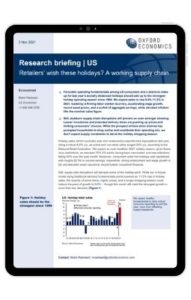US retailers’ wish these holidays? A working supply chain
 Favorable spending fundamentals among US consumers and a desire to make up for last year’s socially distanced holidays should add up to the strongest holiday spending season since 1999. We expect sales to rise 9.5%-11.5% in 2021, fueled by a firming labor market recovery, accelerating wage growth, record asset prices, and a surfeit of aggregate savings, while elevated inflation lifts the nominal sales figure.
Favorable spending fundamentals among US consumers and a desire to make up for last year’s socially distanced holidays should add up to the strongest holiday spending season since 1999. We expect sales to rise 9.5%-11.5% in 2021, fueled by a firming labor market recovery, accelerating wage growth, record asset prices, and a surfeit of aggregate savings, while elevated inflation lifts the nominal sales figure.
What you will learn:
- Leaner inventories and extended delivery times are pushing up prices and limiting consumers’ choices. While the prospect of bare store shelves has prompted households to shop earlier and recalibrate their spending mix, we don’t expect supply constraints to derail the holiday shopping season.
- Holiday sales (which excludes auto and restaurants) outperformed expectations last year, rising a robust 6.8% y/y, as online and non-store sales surged 24% y/y, according to the National Retail Federation.
- While we are bullish on consumer fundamentals driving a record spending season, supply chain issues will play a significant role in shaping this year’s holidays. Typical gifts like apparel and electronics are sated in large part by imports, making holiday sales in the Covid-era highly sensitive to global health conditions and just-in time inventory management.
Tags:
Related Services

Post
Global enterprise tech spend pushed by secular, pulled by cyclical
Global spending on technology products by businesses and governments will grow 5.8% in 2025, adjusted for inflation and currency movement, which is over twice the pace of GDP, according to Oxford Economics’ latest forecasts. Adding the impact of prices and currencies, global enterprise tech spend will increase 7.6%, exceeding $6.5.
Find Out More
Post
After the presidential debate, the US election remains a toss-up
Though Vice President Kamala Harris' chances of winning the election have improved since her debate with former President Donald Trump, we aren't changing our subjective odds for the outcome of the 2024 presidential contest.
Find Out More